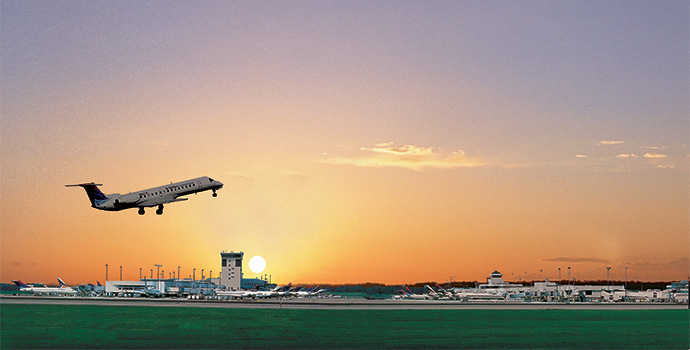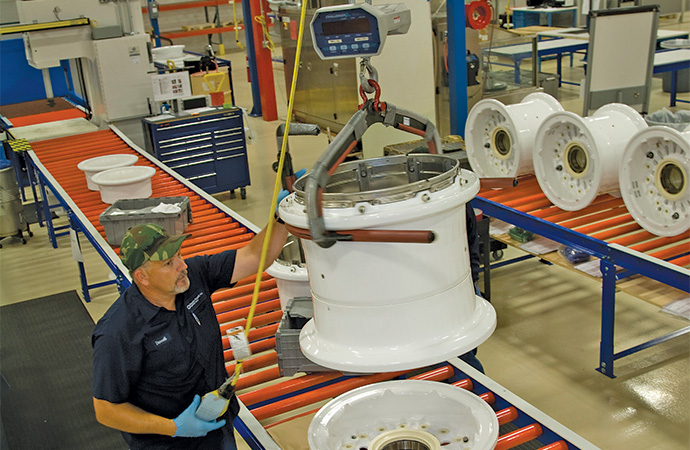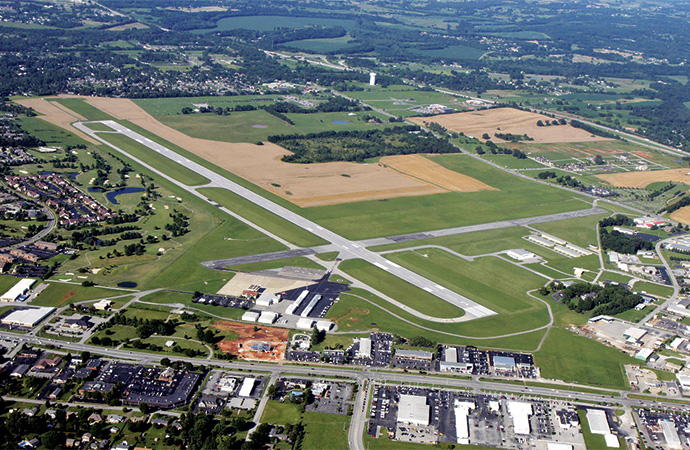Pumping $10 billion into the state’s economy and providing over 100,000 jobs, the aerospace/aviation footprint is expanding in Kentucky in almost every sector from parts manufacturing to supply, from air freight service to education and workforce development. Plenty of factors contribute to the intense interest in Kentucky, chiefly a highly skilled and experienced workforce, excellent infrastructure and location. The Cincinnati/Northern Kentucky region is among the top ranked areas nationally for aerospace products and parts manufacturing, thanks in part to its proximity to the Cincinnati/Northern Kentucky International Airport (CVG).
The Supply Side
Several parts manufacturers and suppliers expanded their Kentucky operations in 2013. Messier-Bugatti-Dowty, a global leader in aircraft landing and carbon braking systems, opened a $50-million expansion at their Walton, Ky., facility producing wheels and carbon brakes systems. The company added an additional 40 percent of space to the existing plant footprint, adding capacity to accommodate production volume and refurbishment of carbon brake disks for commercial and military aircraft.
According to Michelle Lyle, a Messier-Bugatti spokesperson, the growth of carbon brake-equipped fleets of aircraft necessitated the Kentucky expansion, which was selected due to its location, proximity to an international airport (CVG), the technical skills of employees, favorable and stable energy supply and costs, and state and local incentives. “All new aircraft produced are equipped with carbon brakes, so our business grows as airlines acquire new aircraft, particularly when they replace older steel brake aircraft with newer carbon brake aircraft,” she says. The Kentucky plant helps support airline fleets in North and South America as well as the U.S. Air Force, an important customer. Messier-Bugatti supplies 100 percent of the wheels and carbon brakes for the KC-135 and C-17 aircraft.
Indy Honeycomb announced a $915,000 infrastructure expansion in late 2012 that would add an additional 13 jobs. The company, which manufactures metal parts for aircraft engines and other industrial applications, doubled its production space with the construction of a new building next to its existing location.
Meyer Tool, Inc., is adding 28 new jobs at the Meyer Tool Cox Plant in Erlanger, in northern Kentucky. Meyer Tool is a high-tech manufacturing company which supplies precision components to the aerospace and gas turbine engine industries. The Cincinnati-based company also moved its fleet of corporate jets to CVG, taking advantage of the elimination of property tax on non-commercial aircraft in Boone County and bringing an additional eight full-time jobs to CVG to maintain the jets.

The Cincinnati/Northern Kentucky International Airport is a hub for aerospace products and parts manufacturing.
Photo courtesy of Northern Kentucky Tri-ED
Air cargo company Southern Air also chose to relocate its global headquarters to northern Kentucky in 2013 in order to be closer to one of its largest customers, DHL Express, which maintains a worldwide hub at CVG. The move involved an initial investment of $3.5 million and created approximately 150 jobs.
Workforce Development and Education With an Aerospace Twist
None of these moves would have happened without a skilled workforce and specialized training available for companies looking to locate. Fortunately, Kentucky has a stellar reputation in aerospace/aviation workforce development thanks to a strong system of universities and colleges, including community colleges.
Some of the state’s premier programs include Eastern Kentucky University’s comprehensive aviation program including a top-ranked Professional Pilots program, Morehead State University’s Space Science Center and Labs, a research partnership that includes NASA and the University of Kentucky and the Somerset Vocational/Technical Aviation Mechanics program. Embry-Riddle Aeronautical University, a Florida-based university internationally recognized for aerospace and aviation education, has a campus located near Louisville International Airport (SDF) that offers undergraduate and advanced degree programs.

The Messier-Bugatti-Dowty plant in Walton, Ky., manufactures aircraft wheels and carbon brake systems.
Photo courtesy of Messier-Bugatti-Dowty

Regional airports, like Bowling Green/Warren County Regional Airport, play a significant role in promoting
the state’s aerospace/aviation industry.
Photo courtesy of Bowling Green/Warren County Regional Airport
The Institute of Aerospace Education (IAE) is a non-profit devoted to improving student success in the vital science, technology, engineering and mathematics (STEM) subjects and fostering the growth of aerospace careers in Kentucky. The organization interacts directly with students in 23 high schools, providing hands-on experiences by partnering with state agencies, educational institutions and corporations. The Aviation Museum of Kentucky offers academic assistance to educators, providing a “Learning through Aviation” program which incorporates aviation studies into the curriculum, demonstrating the relevance of STEM subjects to aerospace and aviation careers. Each summer, the AMK hosts an Aviation Summer Camp for kids ages 10 to 15 years old. The camp broadens students’ horizons, literally, as hundreds of campers take flight with licensed instructors as part of the program.
Rolling Out the Welcome Mat
The Kentucky Aviation Association (KAA) promotes the aviation industry statewide and the sharing of best practices among its members. “Our members range from very small, rural general aviation airports in remote locations to the largest air carriers in the state of Kentucky,” says Rob Barnett, manager of Bowling Green/Warren County Regional Airport and executive director of the KAA.
Like many regional airports in Kentucky, Bowling Green/Warren County Regional Airport is experiencing sizable growth with economic development driving much of the progress. “Our airport has probably doubled in size of base tenant operation, land leases, fuel sales and those sorts of things in the past 12 months,” says Barnett. “We are fortunate to have I-65 going right through our community. We’re doing major cargo operations for a lot of the automotive manufacturing facilities in town.”
Barnett says he works with the Bowling Green Area Chamber of Commerce almost daily on leads and interacts with the KAA membership regularly about changes in the industry, offering advice about things like risk abatement planning and sharing information about how to help develop their local economies.
He is keenly aware that economic development is often linked to the local airport. “I say our airport is the welcome mat for our community,” he says. “Many times corporations are bringing in their high-level executives and the first image or perception they get of our community is our airport. We’re constantly working to improve facilities and amenities, not only because we want to recruit but because we want to retain. You do that a lot of different ways, coming up with tax incentives or building and maintaining infrastructure to accommodate corporate executives that come into the community without you even knowing they’re on the ground.”
